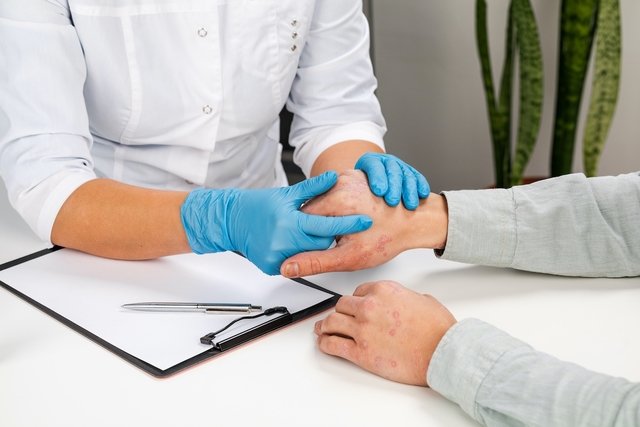Eczema is a type of dermatosis characterized by acute or chronic inflammation of the skin that results in symptoms such as dryness, itching, swelling, blisters and redness of the skin, which can occur in anyone, at any age, but are more common in children.
There are several types of eczema, which are caused by different factors, such as allergies to substances that may have come into contact with the skin or medications, as well as changes in environmental temperature, or being triggered by stress, for example.
The treatment of eczema is carried out by a dermatologist, and the use of moisturizers, corticosteroids, antihistamines, immunosuppressants, biological therapy or phototherapy, for example, may be recommended. It is also important to identify the factor responsible for stimulating the symptoms.

Eczema symptoms
The main symptoms of eczema are:
- Dry skin;
- Peeling of the skin, due to dryness;
- Intense itching;
- Swelling of the skin;
- Redness;
- Blisters on the skin, which can rupture and release liquid;
- Formation of wounds on the skin, due to constant scratching;
- Change in the color of an area of the skin, which may be lighter or darker than normal.
In the chronic phase of eczema, the blisters begin to dry and crusts form, and an increase in the thickness of the skin in the area may also be noted.
In babies and children, eczema is most common on the cheeks, arms and legs, but in adults, symptoms can appear anywhere on the body.
Symptoms may vary according to the cause and type of eczema, and should always be evaluated by a dermatologist, who can recommend the most appropriate treatment to alleviate symptoms and prevent skin infections.
How the diagnosis is made
The diagnosis of eczema is made by a dermatologist through evaluation of the symptoms, as well as their onset and frequency of occurrence, health history and physical examination in which the characteristics of the skin lesions are observed.
Taking care of your health has never been easier!
Generally, no tests are necessary to confirm the diagnosis of eczema, however, the doctor may recommend carrying out an allergy test in order to identify the factor responsible for the eczema. See how the allergy test is done.
Possible causes
The causes of eczema are not yet well understood, however, it is believed that it may occur due to a combination of genetic and environmental factors, which lead to changes in the skin’s protective barrier or the functioning of the immune system.
The main factors that can increase the risk of developing eczema are:
- Family history of eczema or dermatitis;
- Family history of allergies, asthma or allergic rhinitis;
- Extreme heat or cold;
- Low or high air humidity;
- Sweat;
- Allergy to dust mites, mold or pollen;
- Plants or animal hair;
- Cleaning products, such as detergent or laundry soap;
- Dust or pollution;
- Clothes, belts, jewelry or some types of fabric, such as wool or jeans;
- Medicines, such as antibiotics, phenytoin, carbamazepine or lamotrigine;
- Foods, such as peanuts, dairy, egg or soy;
- Materials such as latex or rubber;
- Beauty and cosmetic products, makeup, perfume, shampoo, deodorant, shower gel, soap, wax or depilatory cream;
- Stress or anxiety;
- Depression.
Furthermore, eczema can also appear due to hormonal changes during the menstrual cycle or pregnancy.
Types of eczema
Eczema can be classified into different types according to its cause, the most common being:
- Contact eczema or contact dermatitis: arises due to contact with an irritating or allergenic object or substance, triggering an exaggerated response from the immune system;
- Stasis eczema or stasis dermatitis: it can appear when there is a change in blood circulation in the area, mainly in the legs;
- Eczema from medications: which happens when a person uses a medication that leads to the development of an allergic reaction that results in the appearance of eczema;
- Atopic eczema or atopic dermatitis: it is normally associated with asthma and rhinitis and the symptoms usually appear on the face and in the folds of the arms and legs, in addition to intense itching;
- Nummular eczema or nummular dermatitis: The cause is not yet well established, but in some situations it may be related to excessive dryness of the skin, due to cold or dry weather, for example. This type of eczema is characterized by the presence of red, round patches on the skin that itch;
- Dyshydrotic eczema or dyshidrosis: It can arise due to skin allergies, excessive moisture in the hands or feet and increased physical or emotional stress, which lead to the appearance of small balls filled with liquid in the palms of the hands, on the sides of the fingers or on the soles of the feet.
In children, eczema usually appears after 3 months and can last until adolescence.
How the treatment is carried out
Eczema treatment must be indicated by a dermatologist according to the type of eczema, severity of symptoms and the person’s age and aims to alleviate symptoms and prevent them from recurring, as there is no cure.
Thus, the main treatments that may be recommended by the doctor are:
1. Moisturizers
The use of neutral, fragrance-free moisturizers, which contain a greater quantity of oils, may be recommended as they help to retain and maintain moisture and soothe the skin, reducing the symptoms of eczema and preventing the emergence of new attacks.
2. Medicines
In some cases, depending on the intensity of the symptoms, the doctor may recommend treatment with medications such as:
- Corticosteroid creams or ointmentssuch as betamethasone or dexamethasone;
- Corticosteroids in tablet formsuch as prednisone or prednisolone;
- Oral antihistaminessuch as diphenhydramine or hydroxyzine;
- Immunosuppressive ointmentssuch as pimecrolimus or tacrolimus;
- Immunosuppressants in tablet formsuch as cyclosporine, azathioprine, mycophenolate or methotrexate;
- Biological therapysuch as dupilumab in injection form.
In some cases, the doctor may also recommend the use of antibiotics to prevent or treat skin infections.
3. Phototherapy
Phototherapy with ultraviolet A or B radiation (UVA or UVB) may be recommended by the doctor for moderate eczema that has not improved with other treatments, as it helps to reduce skin inflammation, presenting few side effects compared to other treatments.
Phototherapy can be used together with an oral or topical remedy, psoralen, this treatment being called PUVA, and which consists of taking or applying psoralen in the form of an ointment on the skin, and 2 hours later exposing the area that will be treated with ultraviolet radiation.
Daily care
Some daily care is important to avoid worsening of symptoms or even to prevent symptoms from appearing again, and it is recommended:
- Do not take very hot and prolonged bathsas they dry out the skin;
- Dry your skin after bathing with a soft towelclean and dry, without rubbing the towel too hard on the skin;
- Apply the moisturizer recommended by your doctor daily after bathing, with skin still damp;
- Avoid scratching the location of the affected skin;
- Use neutral soaps and detergentsto avoid skin irritation;
- Avoid using perfume or scented lotions on the skin;
- Avoid contact with substances that may develop or worsen symptoms;
- Wear cotton clothesavoiding those made of synthetic fabrics;
- Avoid wearing tight clothes and with rough fabric;
- Use a room humidifierwhen the climate is very dry or cold;
- Avoid very hot environments that promote sweating.
It is important that this care is continued even when the symptoms of eczema disappear to prevent the skin from becoming too dry and the emergence of new attacks.
Bibliography
- LENIS, L.; ORCHARD, D. Eczema management in school-aged children. Aust Fam Physician. 46. 12; 896-899, 2017
- RAVEENDRAN, R. Tips and Tricks for Controlling Eczema. Immunol Allergy Clin North Am. 39. 4; 521-533, 2019
- ROZALSKI, M.; et al. Atopic and Non-atopic Eczema. Acta Dermatovenerol Croat. 24. 2; 110-5, 2016
- NEMETH, V.; EVANS, J. IN: STATPEARLS (INTERNET). TREASURE ISLAND (FL): STATPEARLS PUBLISHING. Eczema. 2022. Available at: <https://www.ncbi.nlm.nih.gov/books/NBK538209/>. Accessed on March 22, 2023
- NANKERVIS, H.; ET AL. IN: SOUTHAMPTON (UK): NIHR JOURNALS LIBRARY. Scoping systematic review of treatments for eczema. 2016. Available at: <https://www.ncbi.nlm.nih.gov/books/NBK363127/?term=eczema>. Accessed on March 22, 2023
- BRAZILIAN SOCIETY OF DERMATOLOGY. Eczema. Available at: <https://www.sbd.org.br/dermatologia/pele/doencas-e-problemas/eczema/70/#:~:text=O%20que%20%C3%A9%3F-,Eczema >. Accessed on October 15, 2020
- BRAZILIAN SOCIETY OF MEDICINE AND FAMILY AND COMMUNITY HEALTH. Eczema: NHG M37 guideline summary. 2014. Available at: <http://www.sbmfc.org.br/wp-content/uploads/media/NHG%2038%20Eczema(1).pdf>. Accessed on October 15, 2020
- ANTUNES, Adriana A.; SOLÉ, Dirceu; CARVALHO, Vânia O.; BAU, Ana E. K et al. Practical update guide on atopic dermatitis – Part I: etiopathogenesis, clinic and diagnosis. Joint position of the Brazilian Association of Allergy and Immunology and the Brazilian Society of Pediatrics. Arq Asthma Allerg Immunol. Vol 1. 2 ed; 131-156, 2017

Sign up for our newsletter and stay up to date with exclusive news
that can transform your routine!
Warning: Undefined array key "title" in /home/storelat/public_html/wp-content/plugins/link-whisper-premium/templates/frontend/related-posts.php on line 12
Warning: Undefined array key "title_tag" in /home/storelat/public_html/wp-content/plugins/link-whisper-premium/templates/frontend/related-posts.php on line 13



